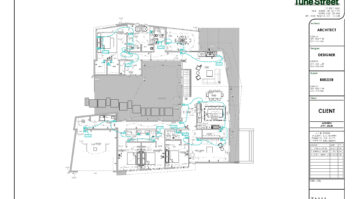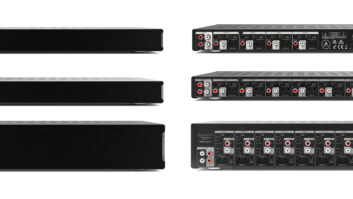by Jeremy J. Glowacki
Once in a while in our relatively small industry, there’s a manufacturer that manages fly under the radar. Until now, SoundCast Systems’ relative obscurity was deliberate to some degree, as the company worked to establish its footing over the past five years with an innovative wireless speaker system. Now that the Chula Vista, California-based manufacturer has established itself with new distribution plans and full product line, it has begun sharing its story and making a confident push into the custom installation and specialty retail channels.
That’s one of the reasons why I went to visit company president Mal Hollombe and his team of engineers and product managers during a recent trip to California. And although I came with the intention of simply hearing an outdoor wireless speaker that I’d only read about and discussed over the phone, I left the company’s office with the realization that SoundCast is than just a manufacture of a strange-looking, portable, wireless outdoor speaker, called the OutCast.


SoundCast president Mal Hollombe.Omar Vasquez, technical support manager for SoundCast, demonstrates the iCast.
It all started back in February when I received a SoundCast press release describing “lucrative opportunities for U.S. dealers and custom integrators.” The news stemmed from recent improvements to the company’s sales and marketing strategy, including the establishment of a custom integrator and AV retail dealer network, just-in-time inventory support for those dealers, increased dealer margins and profits for the direct dealer network, a strategic alliance with The OAC Group and Roberta Lewis & Associates for business, sales and marketing, public relations, and brand development, and new multi-source/multi-zone products for the custom integration channel.
I’m a sucker for a good business story, especially in this economy, but I was even more intrigued by the products that were somewhat cryptically described in the press release as “wireless multi-source and multi-zone audio control systems.” So, I chatted with Hollombe on the phone about these products, and he introduced me to the full SoundCast Systems line, telling me how the brand was a spin-off of an OEM manufacturer that had been building products for other companies for more than 30 years. Then, in 2002, this company developed a separate group of engineers who were asked to focus on developing innovative audio-centric electronics. Looking to gain a leg up on the competition for its OEM business, this group turned its research toward finding a viable approach to wireless audio, eventually selecting 2.4 GHz as its bandwidth of choice.
“When we chose 2.4 Gig, we vowed we were going to do it right,” Hollombe said in our phone conversation. “Our mantra was that is has to sound as good as wired and you cannot be hurt by nor can you hurt other things within the band. I mean, if I’m operating I can’t step on 802.11 devices or WiFi devices, and they can’t step on me.”
So the engineers came up with a technology called Frequency Hopping Spread Spectrum (FHSS), which broadcasts a signal via a transceiver, (the transmitter and receiver are actually talking back and forth, bidirectionally.)
“The receiver module is telling the transmitter module that it has received each packet,” Hollombe explained. “When it doesn’t receive each packet, the transmitter then moves to a different area of the band, broadcasting the signal in a very redundant way, so there’s a tremendously robust signal.”
In contrast, Hollombe offered, a typical home network router uses a direct-sequence spread spectrum on a much narrower and inflexible section of 2.4 GHz band. Using its FHSS technology, SoundCast now claims up to a 350 feet range on its wireless audio products.
But what are these products, exactly?
On my visit to its San Diego-area headquarters, I learned more about the SoundCast’s growing line and how many of them are designed to integrate together to form a wireless multi-room audio system. I received a very well laid out demo/tour throughout SoundCast’s two-story office building in several different rooms that showcased most of its wireless docks, an indoor wireless speaker, various transmitters, and the flagship OutCast and OutCast Junior all-weather speakers. After an introduction by Hollombe, I was guided through the line by technical support engineer Omar Vasquez and firmware engineer Sergio Garzon.
Although some of these products have been around for a while, last month the company started shipping what it calls its “3.4” products, which have been upgraded to allow for three-source and four-zone capability. In other words, each transmitter in Soundcast’s newer wireless products can support up to four zones and each receiver can choose from up to three sources.

Vasquez and firmware engineer Sergio Garzon standing with two OutCasts.
SoundCast’s main focus is most definitely on outdoor audio products, namely its OutCast and OutCast Junior speakers, which look unlike any other speaker product I’d ever seen. The larger OutCast is a cylindrical speaker made of heavy-duty white plastic that is just over two feet high and about 10 inches in diameter. It features a four-inch-high weather-resistant 360-degree metal grille toward the top of the cylinder; this grille covers four, three-inch high-frequency drivers in an omni-directional array. A single, eight-inch down-firing woofer is vented at the bottom of the speaker, and a 100-watt digital amplifier provides the power.
At the top of the cylinder is a handle to help make the OutCast mobile, and also on top are buttons for track forward/track back and play/pause for remote iPod operation, as well as buttons for power, volume up, volume down, and a button to control brightness of a blue LED located at the bass of the speaker. In addition to wireless operation, the Outcast includes an auxiliary input/output jack for connection to other audio devices such as MP3 players and computers. It operates for up to 10 hours on a built-in, rechargeable battery pack, which can recharge while in use, still outputting 400 watts RMS of audio simultaneously.
But the visual description isn’t what’s so important. It’s the performance. Both in SoundCast’s headquarters building and later when I was able to demo the products in my own home, I was blown away with the full-range audio quality demonstrated by the OutCast and its lighter, shorter, and slightly less robust OutCast Junior. I expected nothing short of amazing from my demo in Chula Vista, but it was still impressive to hear wireless speakers performing several rooms apart, without any interference and with such robust bass and clear mid-range detail. Then when I got home and set up my own demo, I was even more impressed with how great both the OutCast and OutCast Junior sounded in the real world. It was impossible for me to detect the difference between a wireless source and one that was directly connected through the auxiliary input in either the OutCast or OutCast Junior.
For my home demo, Hollombe sent me the company’s iCast, which is designed as an iPod dock but can also form a wireless bridge between other MP3 players or a computer. Initial setup was easy, with the only hiccup being the sequence at which you connect the USB cable, launch iTunes, and power up the OutCast.

The OutCast Junior.
As Hollombe pointed out during my California visit, the OutCast and OutCast Junior are voiced as outdoor speakers, so they have much deeper bass than would be required indoors. Nonetheless they both sounded great, even though the 20-inch-tall, 16.5-pound Junior packs a little less of a punch with its 6.5-inch downfiring woofer and 50-watt multi-channel amplifier. My only annoyance with the Junior was that it couldn’t be charged while playing, because its 12-volt NiMH battery pack must be recharged in an “outboard” charging cradle. On the plus side, however, that battery apparently operates up to 18 hours in a battery-saver mode and the speaker is a lot lighter to carry than its “papa.”
Hollombe also sent me the company’s Universal AudioCast Transmitter (UAT), which basically has the same function as the iCast, sans an iPod dock. Unlike the iCast, which requires AC power to operate, the UAT can operate off the USB power provided by the USB connection to the computer, making it completely portable for laptop use. The UAT also has a USB Audio structure inside, which enables it to control basic functions of track forward, track back, pause/play for commonly used media players through USB connection to the PC.
SoundCast also manufactures a wireless subwoofer kit, called the SubCast, which when combined with the UAT can broadcast the LFE signal from a home theater receiver or processor to any powered subwoofer via a wireless link. Hollombe has noticed that SubCast is a great tool for installers trying to “site” multiple subs in a theater.
“There seems to be a Murphy’s Law that Sub Number One is easy to pull wire to, but it’s Sub Number Two that the umbilical cord becomes a big problem,” Hollombe explained. “Determining where you’re going to locate them you can do very easily using Subcast. Plug it into the transmit side and you begin moving the subwoofer around. Obviously it needs power so you’re going to put it where there’s power, but you find out where it sounds best and then determine whether you pull wire to it or not.”
A product that was a part of my big demo system at SoundCast headquarters, but not my home setup, was the company’s tabletop wireless indoor stereo speaker, called SpeakerCast. With the look of a small center-channel speaker in either white or charcoal grey, it can transmit signals up to 150 feet through multiple rooms indoors and incorporates two three-inch full-range drivers and a 50-watt digital amplifier. On top of SpeakerCast are buttons for pause/play and track forward/track back controls for remote operation of an iPod. An included remote has the same features, in addition to on/off, volume up/down, and mute button.

SoundCast’s Universal AudioCast Transmitter.
What’s most notable about SoundCast’s new 3.4 products is that multiple transmitters can now be in close proximity to one another without creating interference. Each transmitter can support four receivers and each receiver can listen to any of three different transmitters and they can be next door to a neighbor that has them as well, and there won’t be any crosstalk.
“The big thing is that we can now go to multiple-dwelling buildings, which is great in the CI world and there don’t have to be the filters,” Hollombe said.In fact, the demo that the company set up for me in California featured three different systems transmitting to up to four receivers each. There was no crosstalk or interference at any time during my visit. Each speaker sounded flawless, whether transmitting iTunes from a computer or directly from an iPhone, or a television show from a TV tuner. Switching from source to source simply required a flip of a switch on both the transmitter and the receiver to enable the two devices to link up.
One of the other cool features is the ability, through a specific combination of button pushes on top of the OutCast or OutCast Junior to switch each of those speakers from stereo to mono left or right to create a large “two-channel” setup outdoors.
What was fun for me in my home demo was streaming my iTunes library wirelessly from my office to the OutCast and taking it around the house with me while I worked on weekend chores. Although I have a wonderful NuVo Renovia multi-room system, sometimes you want to listen to something different from the rest of the family and would like to have your music more “contained,” yet not via headphones. I’ve also enjoyed streaming baseball game broadcasts from mlb.com in the same fashion.
But perhaps my best test for the OutCast will be July Fourth, when my neighbors and I host our annual fireworks show. Each year I take charge of the music “simulcast,” and I always try to top what I did the year before. I actually think that running my iPod playlist directly into the iCast from my iPhone into the OutCast (which will be positioned at the edge of street), will provide excellent coverage of our entire cul-de-sac without the clipping problems that my underpowered outdoor speaker experienced last year when I tried to turn them up too high during the finale. I know the OutCast is waterproof, but I just wonder how it will handle direct hits from bottlerockets.






